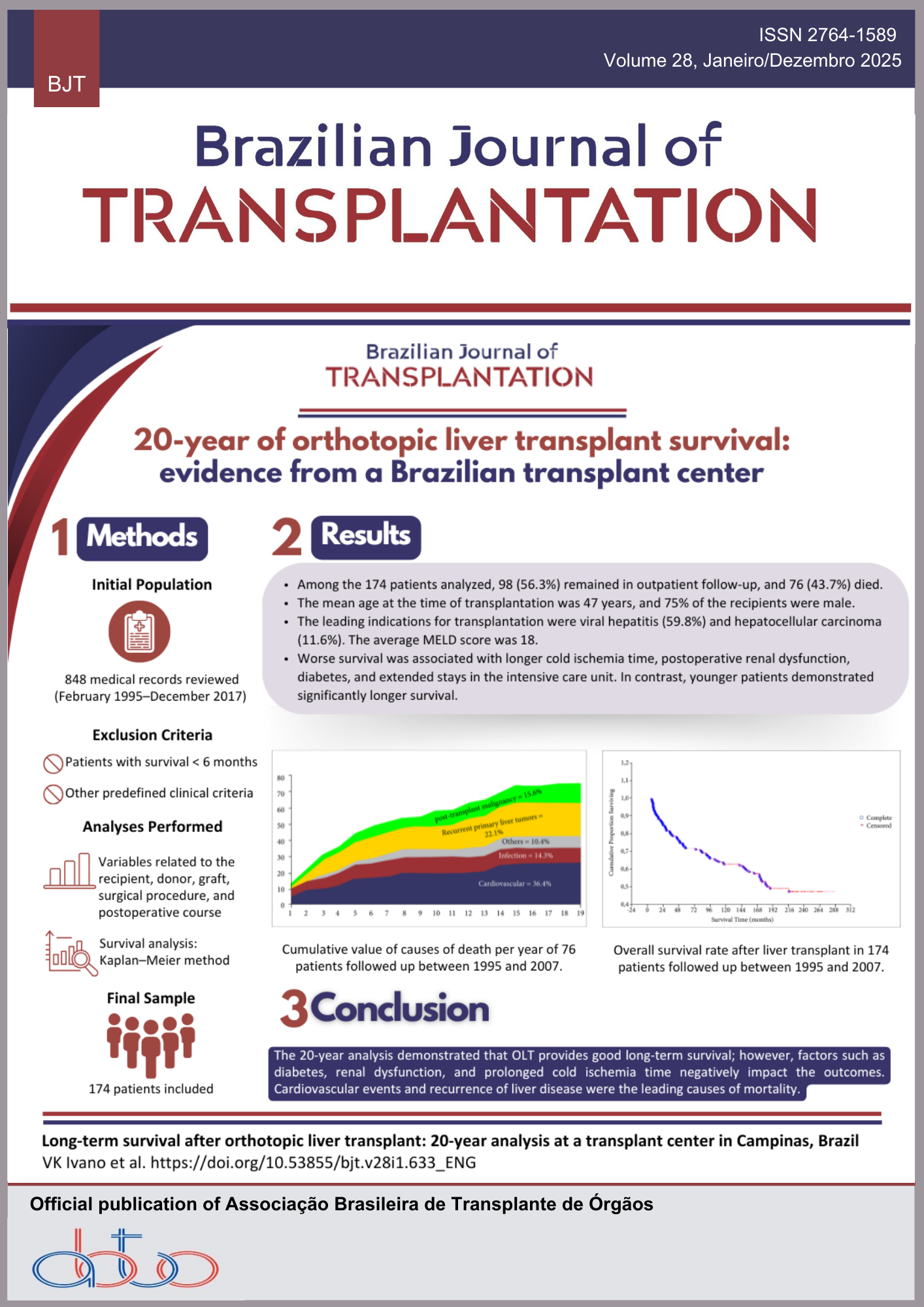Factors Associated with Hospital Readmission in the First Year After Liver Transplantation
Keywords:
Liver Transplantation, Readmissions, SurvivalAbstract
Objectives: Liver transplantation is the primary treatment for various cases of advanced liver disease. The occurrence of complications within the first year post-transplant influences patient survival and quality of life, in addition to increasing healthcare costs. This study aims to analyze potential factors associated with the incidence of hospital readmission after liver transplantation. Methods: A retrospective study was conducted using data from liver transplant recipients at Hospital Felício Rocho who underwent transplantation between July 1, 2018, and June 30, 2022. The study assessed their readmissions and one-year survival, as well as the relationship between these outcomes and donor and recipient data, surgical procedure details, and hospitalization duration for transplantation. Results: The sample comprised 128 cases, with a median age of 57.5 years. Most patients experienced at least one readmission within the first year, totaling 141 readmissions during the period, with infection being the leading cause. In univariate analysis, risk factors for readmission included the need for renal replacement therapy (p = 0.038), intensive care unit (ICU) stay > 8 days (p = 0.023), and hospital stay exceeding 20 days (p = 0.029). In multivariate analysis, ICU stay > 8 days remained associated with readmission, while readmission frequency and underlying liver disease were linked to survival at the end of the period. Conclusions: An ICU stay longer than 8 days is the primary risk factor associated with readmissions within the first year post-transplant. Additionally, readmission frequency and underlying liver disease are factors related to reduced one-year survival.
Downloads
References
Associação Brasileira de Transplantes de Órgãos. Dimensionamento dos transplantes no Brasil e em cada estado. Registro Brasileiro de Transplantes, 2023 [accessed on July, 1st 2023]; XXIX(3). Available in: https://site.abto.org.br/wp-content/uploads/2023/12/rbt2023-3trim-naoassociados.pdf
Comissão Nacional de Incorporação de Tecnologias no Sistema Único de Saúde. Monitoramento de tecnologias incorporadas no SUS – Monitoramento do transplante hepático no Brasil: 2000 a 2015. Brasília, D.F.: Saúde Md; 2021.
Moura MR. Avaliação do custo do transplante hepático em um hospital de atendimento do Sistema Único de Saúde. Belo Horizonte: Faculdade de Medicina da Universidade Federal de Mina Gerais; 2023.
Axon RN, Williams MV. Hospital readmission as an accountability measure. JAMA, 2011; 305(5): 504-5. https://doi.org/10.1001/jama.2011.72
Chen P, Wang W, Yan L, Yang J, Wen T, Li B, et al. Risk factors for first-year hospital readmission after liver transplantation. Eur J Gastroenterol Hepatol, 2015; 27(5): 600-6. https://doi.org/10.1097/MEG.0000000000000327
Paterno F, Wilson GC, Wima K, Quillin III RC, Abbott DE, Cuffy MC, et al. Hospital utilization and consequences of readmissions after liver transplantation. Surgery, 2014;156(4): 871-8. https://doi.org/10.1016/j.surg.2014.06.018
Shankar N, Marotta P, Wall W, Albasheer M, Hernandez-Alejandro R, Chandok N. Defining readmission risk factors for liver transplantation recipients. Gastroenterol Hepatol (NY), 2011 [accessed on July, 1st 2023]; 7(9): 585-90. Available in: https://pmc.ncbi.nlm.nih.gov/articles/PMC3264971/
Pereira AA, Bhattacharya R, Carithers R, Reyes J, Perkins J. Clinical factors predicting readmission after orthotopic liver transplantation. Liver Transpl, 2012;18(9):1037-45. https://doi.org/10.1002/lt.23475
Patel MS, Mohebali J, Shah JA, Markmann JF, Vagefi PA. Readmission following liver transplantation: an unwanted occurrence but an opportunity to act. HPB (Oxford), 2016; 18(11): 936-42. https://doi.org/10.1016/j.hpb.2016.08.003
Yataco M, Cowell A, David W, Keaveny AP, Taner CB, Patel T. Predictors and impacts of hospital readmissions following liver transplantation. Ann Hepatol] 2016 [accessed on July, 1st 2023]; 15(3): 356-62. Available in: https://www.medigraphic.com/cgi-bin/new/resumenI.cgiIDREVISTA=13&IDARTICULO=66502&IDPUBLICACION=6530
Bao X, Wang F. Risk factors for unplanned readmission in adult liver transplant patients: a retrospective study. Transplant Proc, 2024; 56(6): 1385-9. https://doi.org/10.1016/j.transproceed.2024.02.025
Zeidan JH, Levi DM, Pierce R, Russo MW. Strategies that reduce 90-day readmissions and inpatient costs after liver transplantation. Liver Transpl 2018 [accessed on July, 1st 2023]; 24(11): 1561-9. Available in: https://aasldpubs.onlinelibrary.wiley.com/doi/pdf/10.1002/lt.25186
Son YG, Lee H, Oh SY, Jung CW, Ryu HG. Risk factors for intensive care unit readmission after liver transplantation: a retrospective cohort study. Ann Transplant. 2018; 23: 767-74. https://doi.org/10.12659/AOT.911589
Mahmud N, Halpern S, Farrell R, Ventura K, Thomasson A, Lewis H, et al. An advanced practice practitioner-based program to reduce 30- and 90-day readmissions after liver transplantation. Liver Transpl, 2019 [accessed on July, 1st 2023]; 25(6): 901-10. Available in: https://aasldpubs.onlinelibrary.wiley.com/doi/pdf/10.1002/lt.25466
Damazio B, Hao Q, Arenas JD, Riley TR, Hollenbeak CS. Risk factors for 30-day readmission following liver transplantation in Pennsylvania. J Liver Transpl, 2022; 8: 100114. https://doi.org/10.1016/j.liver.2022.100114
Downloads
Published
How to Cite
Issue
Section
License
Copyright (c) 2025 Bárbara Buitrago Pereira, Gustavo Miranda Martins, Antônio Márcio de Faria Andrade

This work is licensed under a Creative Commons Attribution 4.0 International License.









